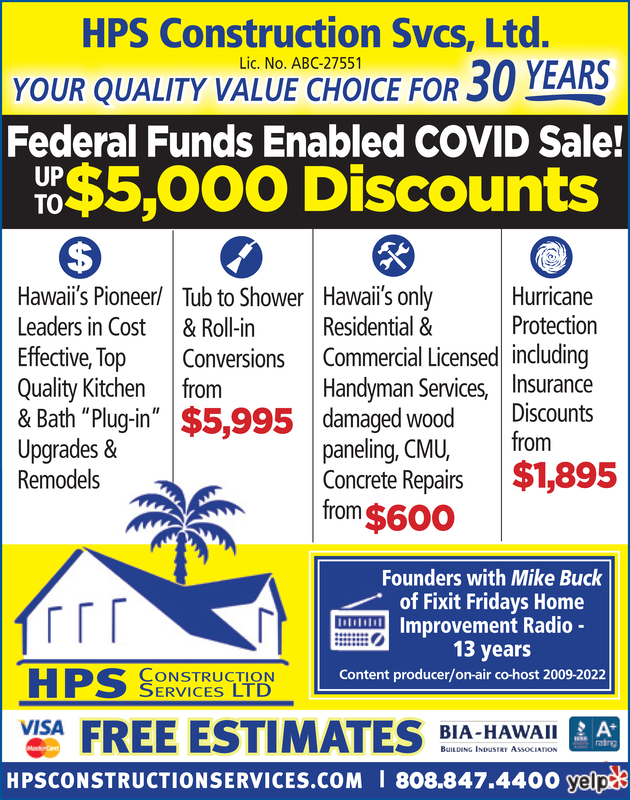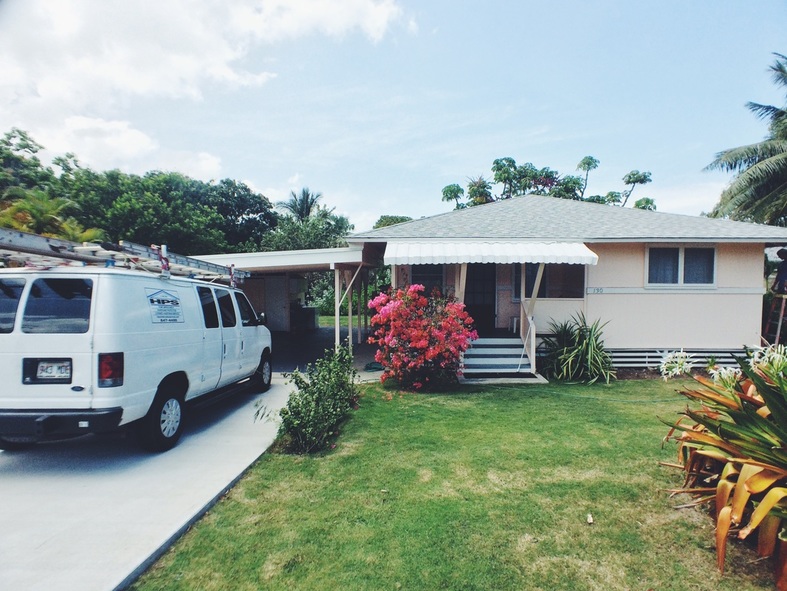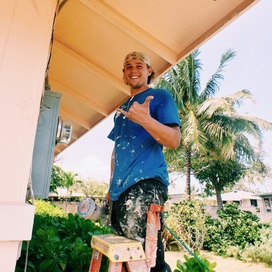Beware—El Nino is back!
Read "Most Hawaii homes aren’t ready if a strong hurricane hits" on SmartNews: https://l.smartnews.com/p-U4F9a/LVNl8m
Hurricane Protection in Hawaii
Hurricane protection is the structural strengthening of your home to better resist the steady force and strong gusts that occur for hours during a tropical storm or hurricane. Hawaii is different than every other coastal state because Hawaii has mountains and valleys and is susceptible to hurricanes from the East, West and South. Due to the warming of waters on the north side of the Hawaiian Islands in 2014/2015, Hawaii was also susceptible from the north, as two storms skirted the islands from the north side. Hurricane damage is something to take seriously. Hurricane Iniki struck Hawaii in 1991 and caused $1.8 billion dollars in damage and claimed 6 lives.
By strengthening the roof to wall, post to beam, and wall to foundation connections, houses are proven to withstand greater wind force. This is the single best way to strengthen your home against hurricane force winds.
As a result, the risk of damage to your home during a hurricane or high wind storm event is significantly reduced. Most hurricane insurers offer discounts on premiums for homes that undergo a hurricane protection retrofit. Hurricane protection retrofits are low cost and can be completed in 1-2 days. Often, the cost of the retrofit will completely pay it self back in a few years due to lower hurricane insurance premiums. Learn more about hurricane insurance discounts.
HPS Construction Services Ltd provides durable and weather tested hurricane protection products. All of our cables, ties, straps, and other components are made from the highest grade, double-galvanized steel available. The hurricane clips we use were developed in a collaboration between HPS Construction Services and Simpson Strong Tie, and are made for protecting Hawaii's homes. Learn more about hurricane clips.
By strengthening the roof to wall, post to beam, and wall to foundation connections, houses are proven to withstand greater wind force. This is the single best way to strengthen your home against hurricane force winds.
As a result, the risk of damage to your home during a hurricane or high wind storm event is significantly reduced. Most hurricane insurers offer discounts on premiums for homes that undergo a hurricane protection retrofit. Hurricane protection retrofits are low cost and can be completed in 1-2 days. Often, the cost of the retrofit will completely pay it self back in a few years due to lower hurricane insurance premiums. Learn more about hurricane insurance discounts.
HPS Construction Services Ltd provides durable and weather tested hurricane protection products. All of our cables, ties, straps, and other components are made from the highest grade, double-galvanized steel available. The hurricane clips we use were developed in a collaboration between HPS Construction Services and Simpson Strong Tie, and are made for protecting Hawaii's homes. Learn more about hurricane clips.
Does your home have hurricane clips?
Hurricane connectors are steel clips and straps that have been designed, tested, and mandated by all building codes for new construction to connect your roof structure to your wall structure. Only houses built in Hawaii since 1994 have hurricane clips mandated by county codes, but not all have clips for V gable peaks and horizontal lookout beams, nor for dutch gable peaks.
Furthermore, NO HOUSES in Hawaii of any year were built with window and sliding door, nor double entry door, stained glass door, nor garage door protection, nor adequate garage roller wheel track hold downs.
Hurricane clips and connectors have been proven throughout the world since 1963, which is why Hawaii counties mandate them for new construction. Learn more here
Call us at 808 847 4400 for help determining whether your house has sufficient protection from existing hurricane clips and straps.
Furthermore, NO HOUSES in Hawaii of any year were built with window and sliding door, nor double entry door, stained glass door, nor garage door protection, nor adequate garage roller wheel track hold downs.
Hurricane clips and connectors have been proven throughout the world since 1963, which is why Hawaii counties mandate them for new construction. Learn more here
Call us at 808 847 4400 for help determining whether your house has sufficient protection from existing hurricane clips and straps.
America’s Fingers-Crossed Strategy for Hurricane Season
Grim forecasts for an active season highlight the gaps in our planning.
- By Juliette Kayyem
According to forecasts from a range of sources, the hurricane season that begins today could be the direst in recorded history. Abnormally warm waters in the Atlantic Ocean, coupled with the persistently strong winds formed by an emerging La Niña weather front, create dangerous conditions that could lead to as many as 25 named storms in the North Atlantic, according to the National Oceanic and Atmospheric Administration. Amid the continuing threat of climate change, Americans can easily become inured to alarming projections year after year. Both the potential size of this year’s hurricanes and their expected frequency threaten to overwhelm society’s ability to help those in danger and make whole anyone who suffers losses.
America’s disaster-preparedness system doesn’t consist only of the Federal Emergency Management Agency and state and local first-response agencies; it also involves logistics supply chains, private and public insurers, and the regulators who shape the built environment. But none of these entities has the muscle or the resources to prepare for disasters that keep on coming—one after another after another.
People are not particularly attentive to risks that get a little bit worse every year, even when they add up, over the course of decades or generations, to a massive problem. And even when insurers jack up rates or drop coverage for people at elevated risk from climate-related disasters, public officials—including those, as I have previously noted, who claim to acknowledge the danger of a warming planet—do their best to dampen the signals that the market is trying to send.
All of which means that, especially if you live in a vulnerable area, the question isn’t whether society is ready for what this year’s weather may hold. It’s whether you are.
Anya Groner: When the place you live becomes unlivable
In an unusually active season, the capacity for governments to respond to every crisis in a timely fashion is likely to be overstretched. In 2017, Hurricanes Harvey, Irma, and Maria hit in a period of about three weeks and set grim milestones: Harvey was the first Category-3-or-higher storm in a dozen years to make landfall in the United States; Irma mustered some of the strongest winds on record in the Atlantic; Maria devastated Puerto Rico and caused a death toll there that is still uncertain but likely exceeds 2,000. According to a subsequent U.S. government report, the magnitude and frequency of the season’s storms—coupled with wildfires ravaging California around the same time—produced significant staffing shortages and supply-chain problems that delayed recovery efforts.
When faced with problems that require tough choices and concerted action, we sometimes look to technology to save us instead. Technological improvements—both in monitoring the natural world and in communicating real-time information to the public through early alerts—should at least buy people time to prepare for or, better yet, get out of the way of hurricanes and other disasters.
Yet even this minimalist strategy doesn’t work. People don’t listen, and they distrust their government. And the data on Americans’ level of preparedness are not inspiring; only 51 percent of Americans believe that they are ready for a disaster, while the latest government data suggest that fewer people signed up for alerts last year than the year before. One of the major factors that is most likely to compel citizens to get ready is whether they or a family member has been harmed by a weather-related disaster. Still, even a close brush with nature can also breed complacency; people who got lucky and managed to muddle through one storm might not ready themselves enough for the next.
Our ability to muddle along as a society may be shrinking as the costs of climate-related disasters mount—and as our awareness grows of the sheer variety of weird and destructive weather that Americans face. In late May, a series of what are known as severe-convective storms led to hail and tornadoes and caused billions of dollars in damage in the Gulf Coast states. In the insurance industry, such events have a clever name—“kitty cats,” because they fall short of natural catastrophes, or “nat cats”—that downplays their significance. Many of them come as a surprise, intensify rapidly, and give the public little time to respond.
All weather forecasts are educated guesses, of course, including those involving the 2024 hurricane system. Still, this season’s predictions are eerily consistent for those monitoring in government, weather companies, and academic institutions, and the least we can do is use the best information we have. The nature of this weather is likely to deprive communities of time to prepare; higher temperatures mean storms get stronger faster. “Big ones are fast,” Ken Graham, the director of the National Weather Service, said on a press call. He added that storms “don’t care about our timelines. Preparedness is absolutely everything.”
America’s disaster-preparedness system doesn’t consist only of the Federal Emergency Management Agency and state and local first-response agencies; it also involves logistics supply chains, private and public insurers, and the regulators who shape the built environment. But none of these entities has the muscle or the resources to prepare for disasters that keep on coming—one after another after another.
People are not particularly attentive to risks that get a little bit worse every year, even when they add up, over the course of decades or generations, to a massive problem. And even when insurers jack up rates or drop coverage for people at elevated risk from climate-related disasters, public officials—including those, as I have previously noted, who claim to acknowledge the danger of a warming planet—do their best to dampen the signals that the market is trying to send.
All of which means that, especially if you live in a vulnerable area, the question isn’t whether society is ready for what this year’s weather may hold. It’s whether you are.
Anya Groner: When the place you live becomes unlivable
In an unusually active season, the capacity for governments to respond to every crisis in a timely fashion is likely to be overstretched. In 2017, Hurricanes Harvey, Irma, and Maria hit in a period of about three weeks and set grim milestones: Harvey was the first Category-3-or-higher storm in a dozen years to make landfall in the United States; Irma mustered some of the strongest winds on record in the Atlantic; Maria devastated Puerto Rico and caused a death toll there that is still uncertain but likely exceeds 2,000. According to a subsequent U.S. government report, the magnitude and frequency of the season’s storms—coupled with wildfires ravaging California around the same time—produced significant staffing shortages and supply-chain problems that delayed recovery efforts.
When faced with problems that require tough choices and concerted action, we sometimes look to technology to save us instead. Technological improvements—both in monitoring the natural world and in communicating real-time information to the public through early alerts—should at least buy people time to prepare for or, better yet, get out of the way of hurricanes and other disasters.
Yet even this minimalist strategy doesn’t work. People don’t listen, and they distrust their government. And the data on Americans’ level of preparedness are not inspiring; only 51 percent of Americans believe that they are ready for a disaster, while the latest government data suggest that fewer people signed up for alerts last year than the year before. One of the major factors that is most likely to compel citizens to get ready is whether they or a family member has been harmed by a weather-related disaster. Still, even a close brush with nature can also breed complacency; people who got lucky and managed to muddle through one storm might not ready themselves enough for the next.
Our ability to muddle along as a society may be shrinking as the costs of climate-related disasters mount—and as our awareness grows of the sheer variety of weird and destructive weather that Americans face. In late May, a series of what are known as severe-convective storms led to hail and tornadoes and caused billions of dollars in damage in the Gulf Coast states. In the insurance industry, such events have a clever name—“kitty cats,” because they fall short of natural catastrophes, or “nat cats”—that downplays their significance. Many of them come as a surprise, intensify rapidly, and give the public little time to respond.
All weather forecasts are educated guesses, of course, including those involving the 2024 hurricane system. Still, this season’s predictions are eerily consistent for those monitoring in government, weather companies, and academic institutions, and the least we can do is use the best information we have. The nature of this weather is likely to deprive communities of time to prepare; higher temperatures mean storms get stronger faster. “Big ones are fast,” Ken Graham, the director of the National Weather Service, said on a press call. He added that storms “don’t care about our timelines. Preparedness is absolutely everything.”
About HPS Construction Services
HPS was formed in 1993 and become the technical innovator and leader in the field of hurricane protection in Hawaii after Hurricane Iniki. We have performed over 3000 installations of our hurricane clips, ties, straps, garage-door, and carport tie-downs throughout the island of Oahu. As installation technology has improved we've been able to bring down the cost of retrofitting with hurricane clips substantially.
HPS Construction Services is also a leading kitchen and bathroom remodeler in Hawaii, specializing in tub to shower conversions and cost-effective solutions for homeowners. We hold both general contracting and general electrical licenses and can take on masonry and other general contracting work. To learn more about our other services visit www.hpsconstructionservices.com.
Gerald Peters is the founder and President of HPS. He was also Content Producer/ live on air Co-host 2009-2022 of the Fix it Fridays home improvement live call in radio show on Salem Broadcasting on The Mike Buck Show.
HPS Construction Services Ltd is A+ rated by the Better Business Bureau (BBB) and members of the Building Industry Association of Hawaii (BIA). We hold both a general contacting license and general engineering license in the State of Hawaii.
Lic. No. ABC-27551. Visit our testimonials page here.
HPS Construction Services is also a leading kitchen and bathroom remodeler in Hawaii, specializing in tub to shower conversions and cost-effective solutions for homeowners. We hold both general contracting and general electrical licenses and can take on masonry and other general contracting work. To learn more about our other services visit www.hpsconstructionservices.com.
Gerald Peters is the founder and President of HPS. He was also Content Producer/ live on air Co-host 2009-2022 of the Fix it Fridays home improvement live call in radio show on Salem Broadcasting on The Mike Buck Show.
HPS Construction Services Ltd is A+ rated by the Better Business Bureau (BBB) and members of the Building Industry Association of Hawaii (BIA). We hold both a general contacting license and general engineering license in the State of Hawaii.
Lic. No. ABC-27551. Visit our testimonials page here.








